Welcome to the Ayurveda Beginners Guide!
Ayurveda is more and more in vogue throughout the world but many users and websites forget a fundamental of Ayurvedic remedies: Ayurveda is a medicine…
Just like self-medication with conventional medicines, Ayurvedic supplements can have more side effects than benefits if not used properly.
This is the reason why I decided to write this Ayurveda Beginners guide. Since I have published several articles on amla, the Indian gooseberry used in Ayurveda for hair, skin and health, more and more readers and acquaintances ask me about other Ayurvedic products. I ask each time their tips to my Indian friends and look for scientific researches. The answer is always clear: the use of ayurvedic medicine requires prior knowledge. It is therefore necessary to limit it to plants whose effects are scientifically recognized, whose side effects and dangers are known, adapted to your constitution – dosha – and by strictly respecting the dosage.
In this Ayurveda beginner’s guide, I have compiled for you the current state of my knowledge on Ayurveda, with the help of my Indian friends, their Ayurvedic doctors and scientific research. I have however limited myself strictly to information that will be useful to you and can be implemented quickly and easily. If you want to know what are the six Samhitas, the Mahabutas, the Dhatus, the Shrotas, the Panchakarma, the Rasayanas, read the very complete article here.
In this guide, you will find:
- What is Ayurveda.
- Its objectives.
- Vata Pitta Khapa body types (doshas).
- Why you should know your dosha.
- A dosha quiz.
- Vata Pitta Khapa characteristics.
- How to balance your dosha.
- The Indian Ayurvedic medicines you can use safely.
- The ultimate anti-stress Ayurvedic plant.
- How to adopt an Ayurvedic lifestyle.
It will be regularly updated according to my new discoveries.
Do not forget that for an important pathology, you must imperatively consult a practitioner, whether he is a generalist, a specialist or an Ayurvedic practitioner. I have seen many questions on forums from people who want to use Ayurveda for a serious pathology, without consulting a specialist!
Updated on 06/08/2022

What is Ayurveda?
The word “Ayurveda” comes from Sanskrit. “Ayur” = life. “Veda” = science, knowledge. We can therefore translate the word as “the science of life” or “the knowledge of life”.
So Ayurveda can be defined as a traditional holistic and non-conventional medicine, taking into account the individual as a whole.
Through this definition, we understand that Ayurveda is much more than a medicine; it is also an art of living, to which its most fervent users will associate self-knowledge, meditation, yoga, knowledge of the world, etc.
It originated in India and was developed by the Rishis, the Sages of ancient India. Originally, the healing practice was based primarily on sound and speech.
Ayurvedic principles.
Ayurvedic therapy has 3 objectives:
- maintaining health (preventive).
- healing of diseases (curative).
- Self-realization.

VATA PITTA KAPHA body types – the 3 doshas
The doshas are the main vital energies of the body, or biological humors. Their balance ensures health. Ayurveda is therefore essentially the science of the doshas.
There are three of them:
- Vata, the kinetic energy, Air, the energy of movement.
- Pitta, the energy of transformation, Fire.
- Khapa, the energy of cohesion, Earth.
Your predominant dosha reflects your main qualities, as well as your tendency to stay healthy or not.
Why do I need to know my dosha?
At birth, each human being is made up of a combination of these three doshas. This is called Prakriti or biological constitution.
Generally, one of these three doshas will be dominant and you will therefore be of Vata, Pitta or Khapa constitution.
When your three doshas are balanced, that is, they are as they were at birth, you are healthy. Conversely, dosha imbalance leads to disease.
Ayurveda will therefore take care of the balance of your three doshas, either as a preventive measure, to avoid you getting sick, or as a curative measure, by rebalancing your doshas to make the disease disappear.
Dosha quiz – What is my dosha?
The real question is: what is my dominant dosha?
To find out, you can take a free online dosha test.
I invite you to go to take the test here. After filling in the questionnaire, you will know what your dominant dosha is.
NOTE: I have both tried the official quiz from Ayurveda France and this one. The results were not the same as the English one is quite thin and not so precise. I would advice you to try several ones. Let us know if you found a good English quiz!
Pitta Dosha.
You now know your predominant dosha.
Like many Westerners, my predominant dosha is Pitta, then Khapa.
The Pitta dosha is the dosha of Fire and Water. It is the energy of digestion, metabolism, transformation. So if, like me, you suffer from heartburn and acid reflux, you have a pitta imbalance!
Pitta also governs joy, courage, willpower, anger and jealousy. Pitta personality is cheerful by nature, has a lively mind and is highly motivated.
Note: you will notice that the author of the illustration below has mistakenly put the characteristics of the balanced Vata personality. It should have been something like: medium bone structure, good muscularity, well proportioned, colorful complexion, oily skin, cheerful, courageous, motivated, passionate, sharp mind.
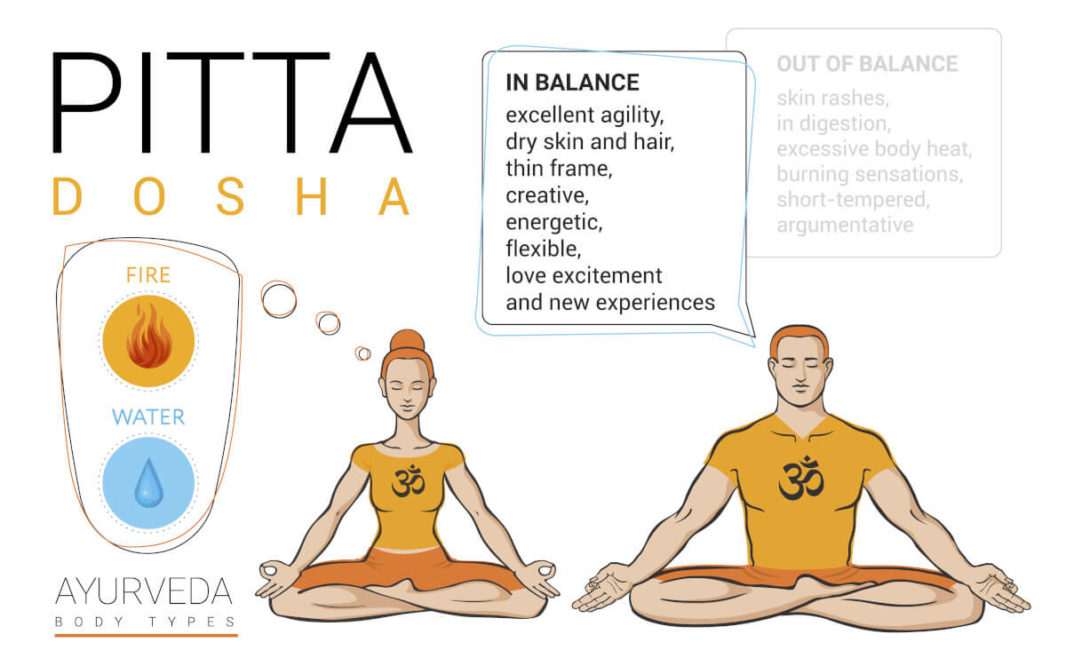
Vata dosha characteristics.
Vata is the dosha of Space and Air. It is the energy of movement and governs the vital force of the body, while giving movement to Pitta and Khapa.
Vata governs communication, creativity, flexibility, speed of thought. A Vata individual is active, creative, an innate communicator.
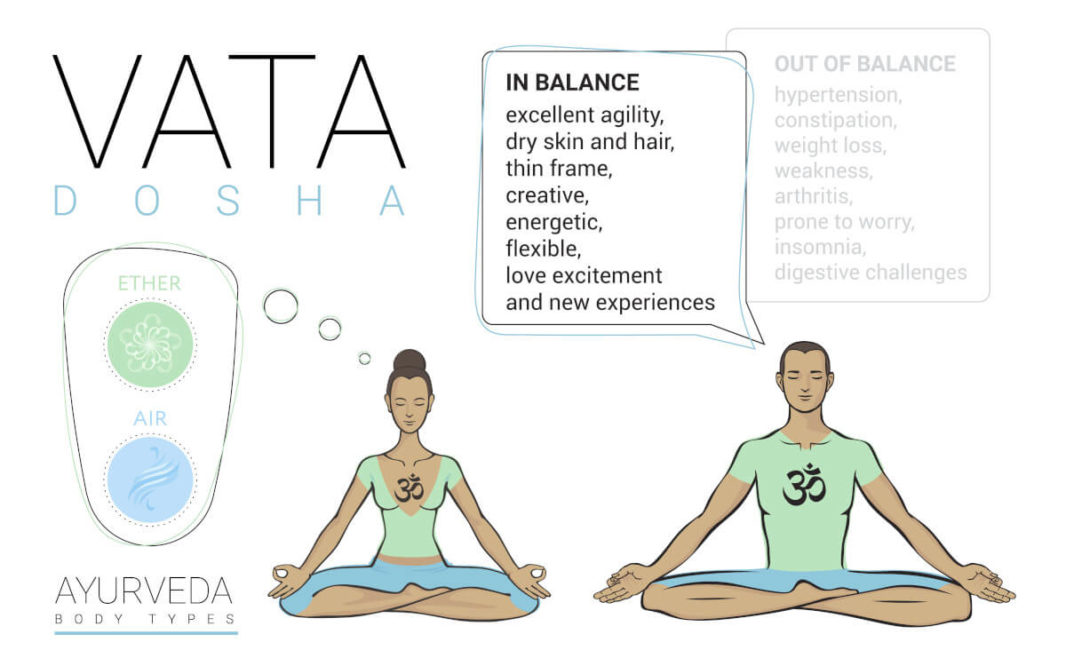
Khapa dosha.
Khapa is the dosha of Earth and Water. It is the energy of construction and lubrication and ensures the body’s structure and proper functioning.
Kapha governs love, patience and forgiveness. A Kapha individual is loving, loyal, faithful and caring.

How to balance your dosha?
It depends on each dosha. However the balance will go through two main ways:
- a diet and ayurvedic plants adapted to your dosha type.
- activities and exercises that counterbalance your temperament (calm and gentle for the superactive Vata, relaxing for the bubbly Pitta, stimulating and intense for the calm Kapha).
You understand why not just anyone can take any Ayurvedic treatment and why it is so important to have some basics…
In the book below, you will find recipes according to your dosha type.
Note: I get commissions for purchases made through links in this post at no extra charge for you.
Which ayurvedic plants and asian products are safe to use?
If there is one Ayurvedic herb that is suitable for all types of doshas, it is amla!
I use it mainly in oil for my hair and skin, and in tablets to boost my immune system.

The ultimate guide to amla
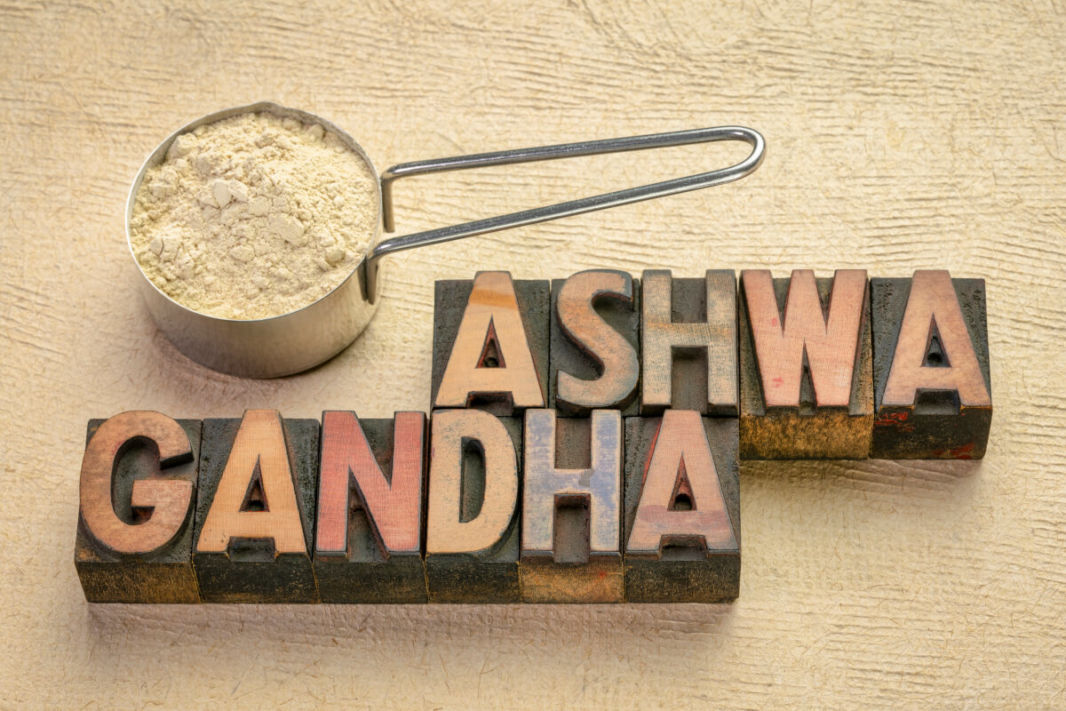
Ashwagandha

Tiger Baulm
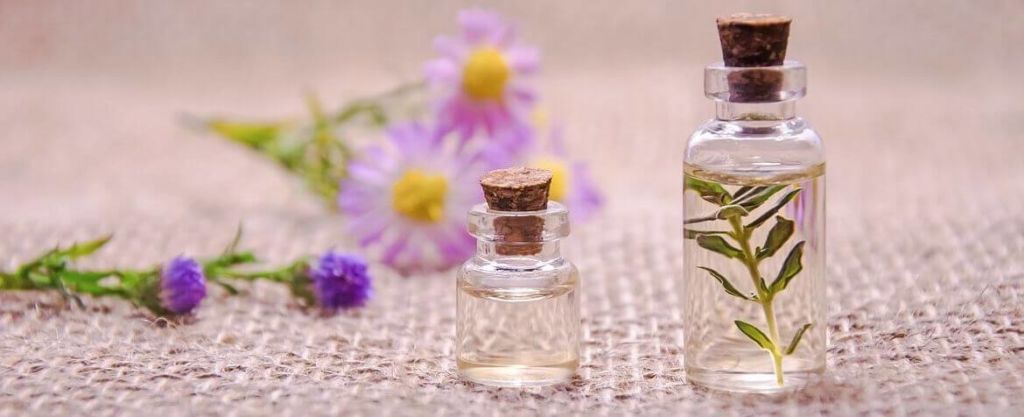
16 hair products
This is the organic amla oil I use for my hair and skin (I make my own anti-aging serum and amla is the most antioxidant food in the world – read the amla guide above to get my tips for my hair and skin). Click on the picture to order. This is the only brand I recommend, being the only pure, 100% amla and totally organic oil that you can get from India.
On the right, these are the tablets I take in the afternoon (for Pitta) with a little warm water and honey (in the morning for Kapha, in the evening for Vata). Take only two tablets, as opposed to the much too high dosage indicated on the box. I take two-month cures from time to time to boost my immune system and nourish my skin and hair from the inside. Click on the pictures to order or links.
Adaptogenic plants.
An adaptogen plant is a medicinal plant that increases resistance to stress, concentration, performance and endurance in case of fatigue or stress. It can simply be called an anti-stress plant!
In the table below, you can see that amla and ashwagandha are included. However, my Indian friends use ashwagandha instead, the anti-stress plant par excellence in India. Be careful though: if you suffer from a Pitta imbalance, you should not use ashwagandha, as it heats up the body even more and thus amplifies the imbalance. Also, read my article about ashwagandha to avoid overdosing and learn how to use it.
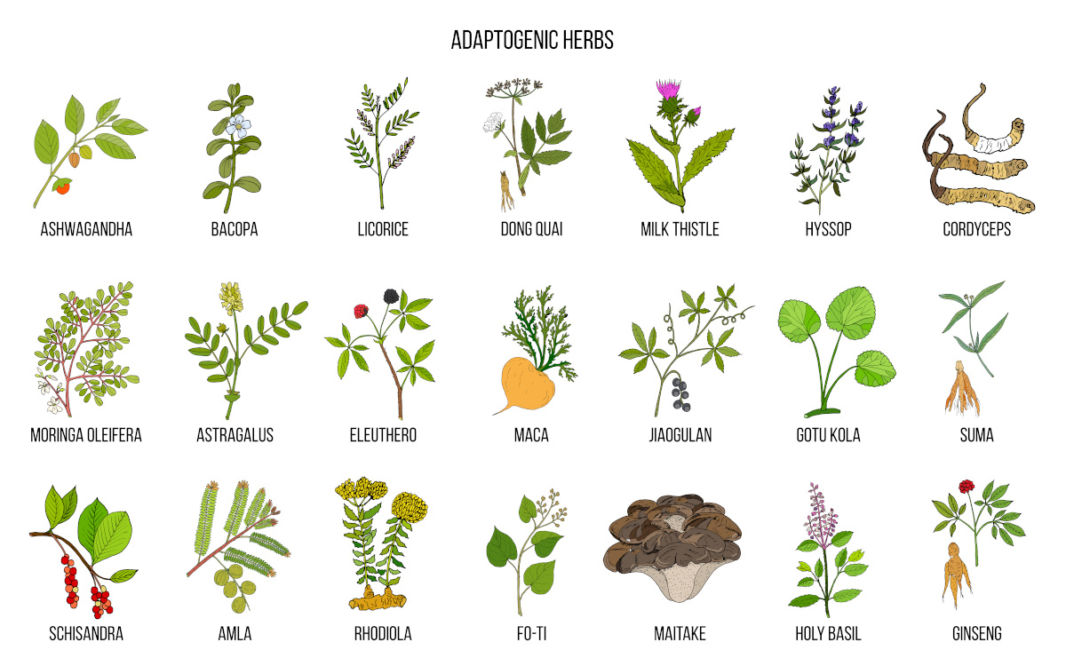
How to improve your health thanks to Ayurveda?
There are a number of simple things you can do right now to improve your health through the principles of Ayurveda. You will see that you are certainly already doing some of them! I have deliberately put the ones that are valid for the three doshas.
Consistency.
- Eat at regular times.
- Go to bed and get up at a regular time.
- Establish a certain routine in your activities, especially to calm Vata and Pitta who tend to be very active physically or mentally.
Mindfulness meditation.
For some time now, I have been practicing both mindfulness and loving-kindness meditation.
Both have their particularities and advantages.
Mindfulness meditation, practiced on a regular basis (10 to 15 minutes a day with Insight Timer for example), will allow you to be much more centered in the present moment, the famous “here and now”. This means:
- better concentration.
- a brain that is much less in turmoil.
- a better appreciation of each moment and each task. It is for example fundamental to eat slowly and calmly so that a Pitta individual feels satisfied without large quantities.
- a greater attention to the visual, sound, tactile, olfactory, gustatory environment and to people.
- a greater serenity.

The use of oils for cooking and massage.
Each dosha has three different oils. These are the ones to be favored for cooking – you will digest better, and for massages.
While my mother always cooked with margarine, I naturally turned to olive oil many years ago. And guess what? Margarine is not good for Pitta, unlike olive oil!
For some time now, I have been in the habit of massaging my body with coconut oil every morning before my shower. These massages improve blood circulation and calm the mind. Coconut oil is great for bringing a cooling sensation to the hot Pitta body.
For Khappa women, I recommend almond oil, as mustard oil has a very masculine smell.
For Vata constitutions, use sesame oil. You can also use it in the morning, 2 to 5 drops in the nostrils to clean the sinuses.

Click on the photos below or the links marked “here” to order almond, sesame or coconut oil.
Ayurveda Kerala.
Kerala in South India is a perfect destination if you want to do an ayurveda cure.
My ayurvedic treatment in Sri Lanka.
In Sri Lanka, I had to see an Ayurvedic doctor for an extremely swollen and painful cyst.
After preparing the paste to apply to the wound, she recited mantras before applying it. She had been trained in Nepal by great Buddhist masters.
The treatment had the desired effect: all the inflammation went back up in a few days and the cyst burst. I still had to take antibiotics and have it cleaned out by a doctor. However, it was never supposed to come back.
A few years later, I had it removed, but it only contained water…
Beginners books on Ayurveda.
If you wish to complete your skills, there are many books available. The book below is particularly appreciated. You can read the readers’ opinions and order by clicking on the picture below or here.

Ayurveda training.
You can find professional trainings on the official website of Ayurveda for your country, but also practitioners, generally classified by region.
Conclusion – Ayurveda Beginners Guide.
With this Ayurveda Beginners Guide, you should now have an easy-to-implement practical foundation to start using Ayurveda in your daily life.
Thanks to Ayurveda and the practice of mindfulness meditation, I was able to do what I had never been able to do before: put my brain in pause mode and stop thinking about 100,000 things at once. A real peace of mind for the body and the mind!
Have you adopted Ayurveda in your daily life? Tell us about your experience in the comment section below!
You can find more tips here: tips and buying guides
Products mentioned in this article.
- Eat Feel Fresh
- Amla oil
- Amla Tablets
- Insight Timer – Free App
- Almond oil.
- Sesame oil.
- Coconut oil.
- Ayurveda for idiots
This article contains compensated links. As an Amazon Associate I earn from qualifying purchases. Consult the disclaimer on the site for more information.
Notes and References.
- Ayurveda – Hopkins Medicine
- Rishi
- Dosha – Wikipedia
- Dosha Test – Chopra
- Adaptogenic plants – National Library of Medicine







